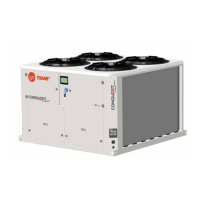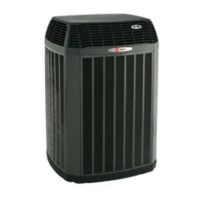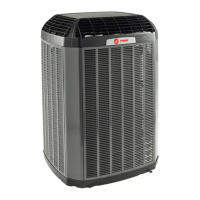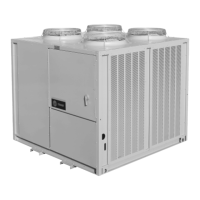Do you have a question about the Trane CONQUEST CGAX 040 SE-SN and is the answer not in the manual?
Highlights potential hazards and precautions for safe operation and maintenance of the equipment.
Crucial guidelines to prevent death, injury, or equipment damage during service visits.
Explanation of various warning symbols found on the unit for safety and proper handling.
Comprehensive list of checks for installers before unit start-up to ensure readiness.
Methods to protect the unit from freezing, including heaters, heat tape, and inhibitors.
Recommendations for using glycol as a freeze inhibitor, including concentration guidelines.
Glycol percentage curves for various temperatures and types, ensuring efficient freeze protection.
Safety and compliance requirements for field power supply wiring, including grounding.
Explanation of how Variable Primary Flow controls pump speed based on Delta T.
Installer checks required before unit start-up, including level, clearances, and water circuit.
Ensuring proper chilled water flow rates for optimal performance and heat transfer.
Detailed steps for starting the unit, including checks on compressors, wiring, and parameters.
Checks and settings for compressors, including oil level, electrical connections, and rotation.
Verification of power wiring, control wiring, motor isolation, and rotation.
Verifying voltage, currents, temperatures, pressures, and superheat/subcooling post start-up.
Final inspection of the unit after successful start-up, ensuring cleanliness and valve positions.
Verification of pump operation and compressor start-up conditions for correct operation.
Procedures for restarting the unit after seasonal shutdown, including checks and oil analysis.
General guidance for qualified technicians on required maintenance tasks for unit longevity.
Specific checks, analyses, and record-keeping required after the initial 500 hours of operation.
Comprehensive tasks for annual maintenance, including system checks, calibration, and oil changes.
Step-by-step procedure for replacing a failed compressor, including lifting and rigging.
Actions to take after mechanical compressor failure, including oil and filter changes.
Actions for electrical compressor failure, including oil testing and filter drier replacement.
Procedure for correctly replacing the evaporator, ensuring proper refrigerant and water connections.
Actions for diagnosing and resolving compressor start-up failures like motor issues or power cuts.
Steps for troubleshooting low refrigerant pressure cut-outs, including leak repair.
Steps for troubleshooting high discharge pressure issues, including water flow and cooling demand.
Diagnosing and resolving short-cycling issues, often related to filter driers or expansion valves.
Troubleshooting excessive cooling demand or high temperatures affecting compressor operation.
Addressing problems causing reduced cooling output or high water temperatures.
Diagnosing and fixing issues leading to excessively high discharge pressure, like poor airflow.
Troubleshooting causes for high suction pressure, such as excess cooling demand.
Diagnosing and resolving issues causing low suction pressure, often related to filter driers.
| Model Number | CGAX 040 SE-SN |
|---|---|
| Category | Heat Pump |
| Cooling Capacity (BTU/h) | 40, 000 |
| Voltage (V) | 208/230 |
| Phase | 1 |
| Refrigerant | R-410A |











